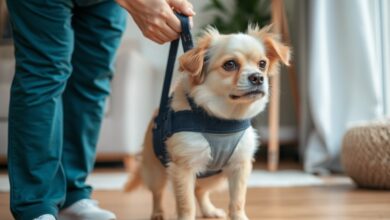Cane Corso Ear Crop Process – Proper Steps
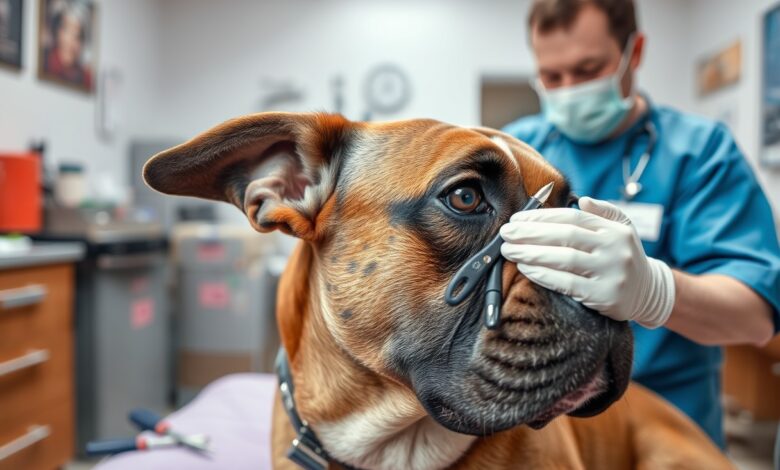
It’s crucial for you to understand the Cane Corso ear crop process, as this procedure affects your dog’s health and appearance. With proper knowledge, you can ensure a safe recovery and positive outcome. This guide will walk you through the necessary steps, from preparing for the procedure to caring for your pup post-surgery. Be sure to follow Ear Crop Discharge Instructions to promote healing and avoid complications. Your diligence is key in this process!
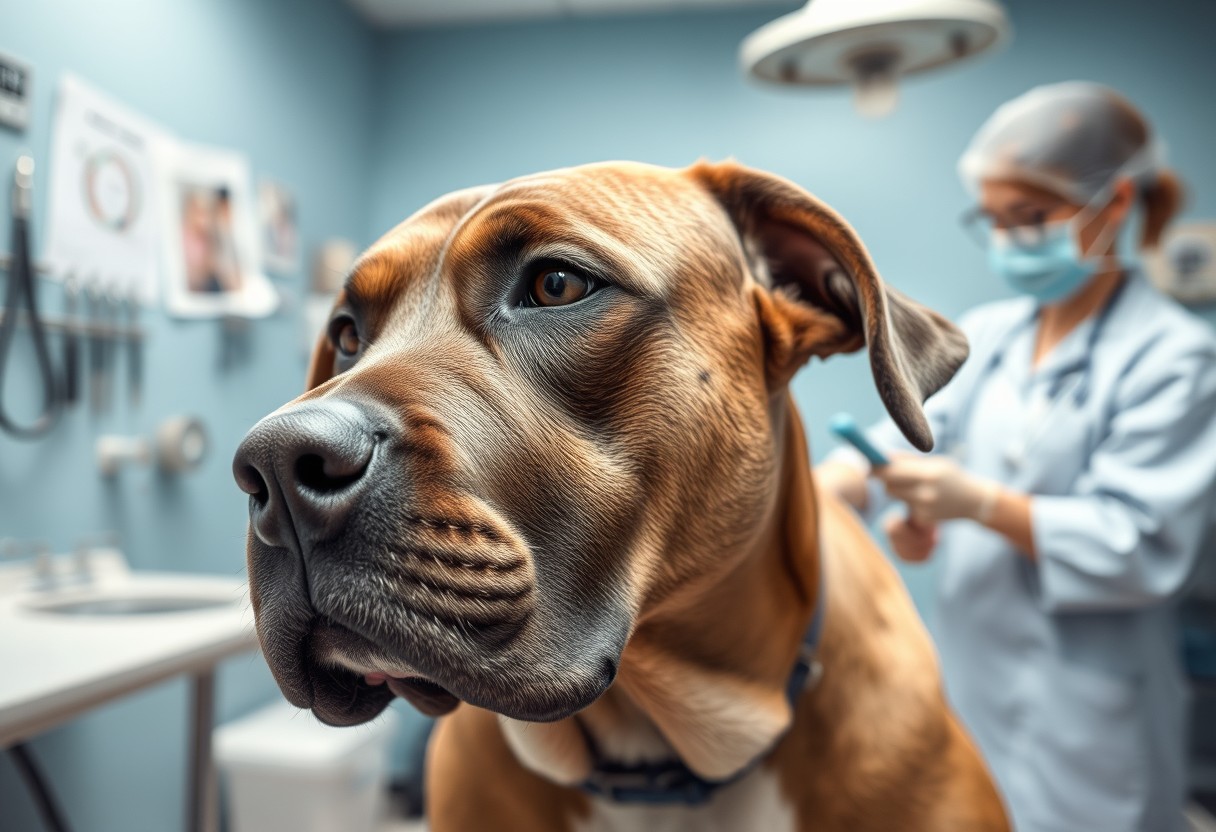
Key Takeaways:
- Preparation: Ensure that the Cane Corso is healthy and has received proper veterinary care before starting the ear crop process.
- Post-Procedure Care: Follow detailed aftercare instructions to promote healing, including monitoring for infections and keeping the ears clean.
- Professional Help: Always consult a qualified veterinarian or a professional breeder for the procedure to ensure the best outcomes for the dog’s health and appearance.
Understanding Ear Cropping
For many Cane Corso owners, ear cropping is a topic of great interest and sometimes controversy. It’s imperative to understand the reasons behind this procedure before making a decision. If you’re unsure, you may want to read more about whether you should crop your dog’s ears by checking out this I have a 4-week-old Cane Corso. I saw some people … article.
Historical Background
Historical accounts suggest that ear cropping dates back to ancient times, primarily among working breeds. The Cane Corso was often used for protection, hunting, and as a guard dog. Ears were cropped to prevent injuries during dog fights or encounters with wild animals, enhancing the breed’s ability to effectively perform its roles.
Purpose and Benefits
Purposefully cropping your Cane Corso’s ears offers various benefits, aligning with breed standards and owner preferences. Primarily, this procedure is thought to enhance the dog’s appearance, giving it a more imposing look. Cropped ears may also help in maintaining ear health by minimizing moisture accumulation, which can lead to infections.
Another key benefit is the potential for clearer communication between you and your dog. Cropped ears can enhance their ability to hear and respond to commands while offering a more alert appearance, which can deter intruders. However, you should also consider the ethical implications and possible health risks associated with ear cropping, ensuring that you make an informed decision based on your priorities and values.
Preparing for the Ear Crop
If you have decided to move forward with an ear crop for your Cane Corso, it’s crucial to prepare adequately. This involves gathering information about the procedure and understanding the steps necessary to ensure a smooth process. Proper preparation will not only help your dog, but it can also ease your anxiety regarding the surgery.
Choosing a Qualified Veterinarian
Qualified veterinarians will have significant experience and expertise in performing ear crops, particularly for Cane Corsos. Look for a vet specializing in canine surgery with positive reviews and recommendations. It’s imperative to discuss the procedure in detail, ensuring that you feel comfortable with their approach and that they are knowledgeable about proper post-operative care.
Pre-operative Care
Any ear cropping procedure begins with specific pre-operative care that is vital for your Cane Corso’s safety. Ensure your dog is up to date on vaccinations and free from parasites, which helps reduce the risk of complications during surgery. Your veterinarian may also recommend fasting your pet for a certain period before the procedure to minimize the chance of nausea or other issues during anesthesia.
Understanding pre-operative care is crucial for your dog’s well-being and safety. Ensure that your Cane Corso has undergone a complete health check to identify any underlying conditions that might pose a risk. Providing your pet with a comfortable, stress-free environment leading up to the surgery is imperative, as anxiety may lead to complications. Keep your dog’s environment calm and supportive, ensuring they are well-hydrated and have access to appropriate exercise while avoiding strenuous activity.
The Ear Crop Procedure
Now that you understand the importance of ear cropping for your Cane Corso, it’s imperative to explore into the ear crop procedure itself. This process involves a surgical approach where the veterinarian carefully removes a portion of the ear, shaping it according to breed standards and your preferences. It’s crucial to choose a qualified veterinary professional who has experience in ear cropping to ensure that your pet receives the best care possible throughout the surgery.
Anesthesia and Surgical Techniques
Procedure begins with administering anesthesia to your Cane Corso to ensure they remain pain-free and calm during the surgery. A skilled veterinarian will then use specific surgical techniques, such as scalpels and surgical scissors, to carefully excise the desired portion of the ear. It’s vital that this process is done with precision to promote proper healing and optimal aesthetic results.
Duration and Recovery
To better understand the timeline for ear crop surgery, the entire procedure typically lasts between one to two hours, depending on the complexity of the desired ear shape. Following the surgery, your Cane Corso will require an adequate recovery period, which can take a few weeks. During this time, it’s important to monitor the surgical site and follow your veterinarian’s post-operative care instructions closely.
Understanding the duration and recovery process is critical for ensuring that your Cane Corso heals properly after ear cropping. The initial recovery may involve some discomfort, and your vet will provide pain relief solutions. It is crucial to keep the ears clean and dry to prevent infections, as this can lead to complications. You should also expect regular follow-up visits to ensure proper healing and to manage any potential risks. By staying attentive and following your vet’s guidance, you will help make the recovery process as smooth and comfortable as possible for your beloved pet.
Post-Operative Care
Not neglecting post-operative care is crucial for a smooth recovery after ear cropping. Following the procedure, your Cane Corso will require close attention to ensure proper healing. This includes managing pain, monitoring the surgical site, and adhering to any veterinarian-recommended protocols. Recognizing potential complications early will help maintain your dog’s health and prevent unnecessary discomfort.
Pain Management
To effectively manage pain after ear cropping, your veterinarian will likely prescribe pain relief medications. It’s crucial to follow the prescribed dosage instructions meticulously to keep your Cane Corso comfortable. By proactively addressing pain, you can help your dog recover more quickly and reduce the risk of complications.
Wound Care and Monitoring
Post-operative care for the surgical site is crucial for proper recovery. With keen attention to your Cane Corso’s ears, you should routinely check for signs of increased redness, swelling, or discharge, which could indicate an infection. Keeping the ears clean and protected from unnecessary trauma is vital. Additionally, ensure that your dog doesn’t scratch or rub the area, as this can lead to serious complications. Regular vet check-ups are also crucial to ensure that the ear cropping is healing as intended, allowing for a positive outcome.
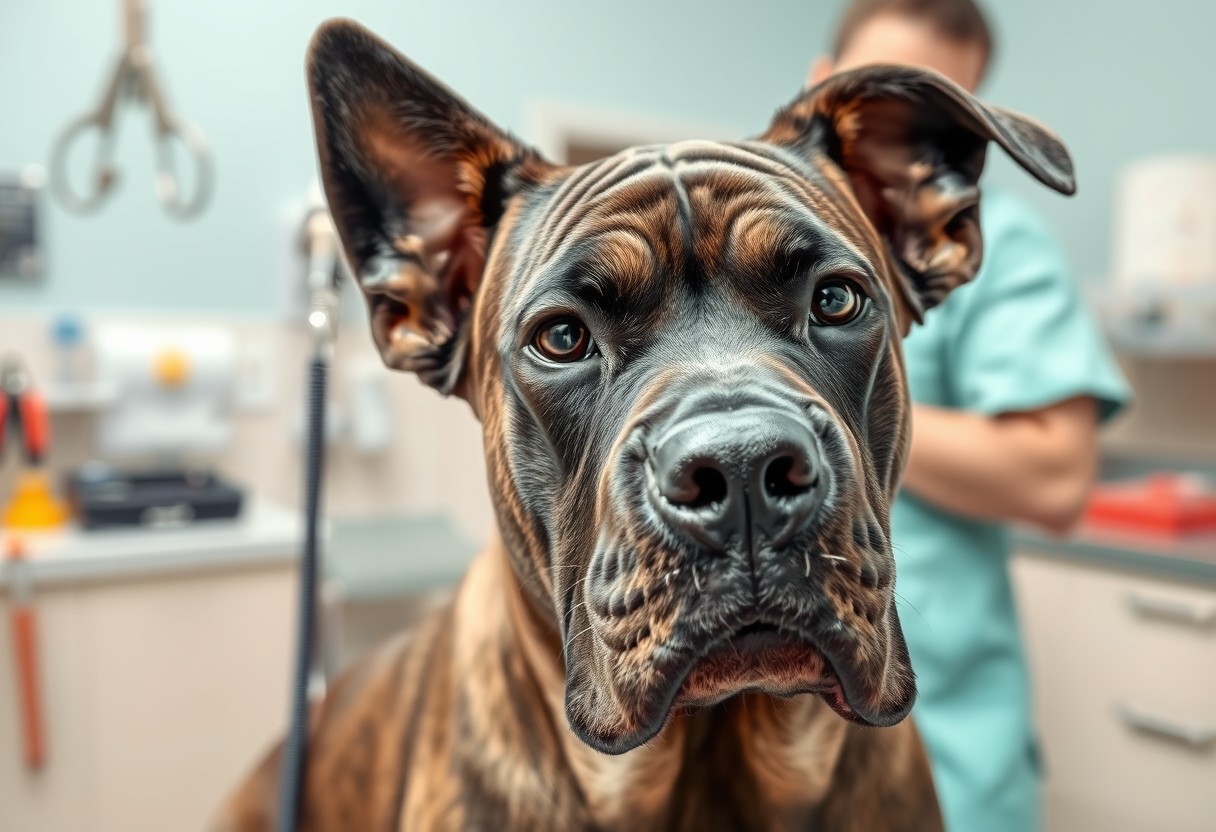
Healing Process
Despite the initial discomfort your Cane Corso may experience post-surgery, the healing process is crucial for the success of the ear cropping. Regular follow-ups with your veterinarian are vital to ensure a smooth recovery. To learn more about the traditional and aesthetic considerations of the procedure, check out Cane Corso: Ear Cropping, Aesthetic Practices & Traditions.
Expected Timeline
The healing process typically spans from 10 to 14 days, during which your puppy’s ears will gradually stabilize and begin to stand upright. However, full recovery may take several weeks before the ears achieve their final look.
Signs of Complications
Any abnormalities during the healing process may indicate complications. You should watch for increased swelling, discharge, or persistent bleeding, as these could signify infection, which requires immediate veterinary attention.
This is especially important as early intervention is crucial. A redness around the incision site, foul-smelling discharge, or excessive licking are disturbing signs that imply your pup may experience a severe infection. Furthermore, ensuring that your Cane Corso is not scratching or manipulating its ears will contribute greatly to a positive healing experience. Recall, promptly addressing any complications will significantly enhance your dog’s recovery. Stay vigilant!
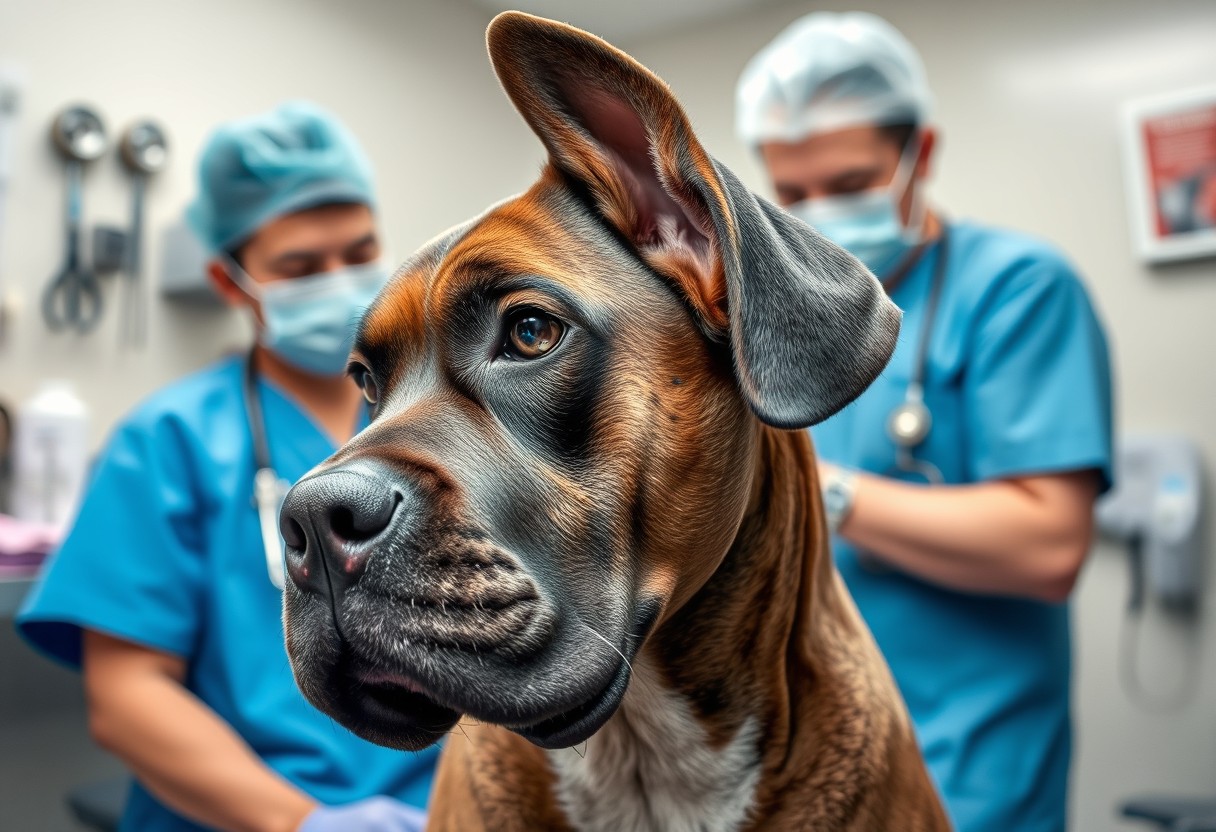
Legal and Ethical Considerations
To ensure you navigate the complexities of ear cropping for your Cane Corso, it is imperative to understand the legal and ethical implications surrounding the procedure. Various regions have different laws that may either allow, regulate, or prohibit ear cropping. Adhering to these laws not only safeguards your interests but also upholds the well-being of your pet. Always consult a veterinarian familiar with both local regulations and ethical practices before proceeding.
Laws on Ear Cropping
Any decision regarding ear cropping should begin with an understanding of the legal framework in your area. Some countries and states have outright bans on the procedure, while others may allow it under specific circumstances. Make sure to research and comply with these laws to avoid any potential legal consequences.
Ethical Debate in Dogs
The ongoing ethical debate surrounding ear cropping often centers on the welfare of the dog versus traditional practices. Many argue that cropping is an unnecessary cosmetic procedure that can cause pain and suffering, while others believe it is a longstanding custom that provides benefits like reduced ear infections. The key is to weigh the impact that the procedure may have on your Cane Corso’s quality of life.
Dogs, like all pets, deserve a life free from unnecessary suffering. Proponents of ear cropping argue that it can enhance the dog’s appearance and may prevent certain health issues, while detractors highlight the potential risks, such as pain and the risk of complications from surgery. Ultimately, you should consider your dog’s individual needs, the potential for pain, and the values that shape your decisions as a responsible pet owner. You must also stay informed about evolving views on animal ethics, which continue to shape our understanding of what is best for your furry friend.
Summing up
Hence, understanding the Cane Corso ear crop process is crucial for ensuring the health and aesthetic appeal of your pet. By following the proper steps — from selecting a qualified veterinarian to post-operative care — you can minimize risks and promote a successful recovery. Bear in mind, this procedure requires careful consideration and commitment, so take your time to educate yourself and consult with professionals before making a decision. Your Cane Corso deserves the best care to thrive and look their finest.
Q: What is the purpose of ear cropping in Cane Corsos?
A: Ear cropping in Cane Corsos is done primarily for aesthetic reasons and to adhere to breed standards, as many owners prefer the traditional look of cropped ears. Additionally, some believe that cropping can reduce the risk of ear infections and improve the dog’s hearing. However, it is important to note that ear cropping is a surgical procedure and should only be performed for valid reasons by a qualified veterinarian.
Q: What are the proper steps to take when considering having my Cane Corso’s ears cropped?
A: The proper steps to take when considering ear cropping for your Cane Corso include the following: first, consult with a qualified veterinarian who is experienced in ear cropping to discuss the potential benefits and risks. Second, ensure the procedure is performed at the appropriate age—typically between 8 to 16 weeks old. Third, choose a reputable veterinarian or veterinary surgeon who follows safe surgical practices. Lastly, follow all post-operative care instructions diligently to ensure proper healing, which includes keeping the ears clean and monitoring for any signs of infection.
Q: What should I expect during the recovery process after ear cropping?
A: During the recovery process after ear cropping, you can expect your Cane Corso to experience some swelling and discomfort, which is normal. It is imperative to keep the dog calm and restrict physical activity to prevent injury to the ears. The veterinarian will provide specific aftercare instructions, which may include applying ointments, cleaning the ears, and possibly using a cone to prevent the dog from scratching at the ears. Follow-up appointments may also be needed to check on the healing process and to schedule any necessary bandage changes. Monitoring for signs of infection or complications is crucial to ensure a smooth recovery.



